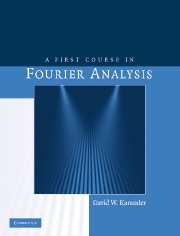Book contents
- Frontmatter
- Contents
- Preface
- 1 Fourier's representation for functions on, Tp, and ℙN
- 2 Convolution of functions on, Tp, and ℙN
- 3 The calculus for finding Fourier transforms of functions on ℝ
- 4 The calculus for finding Fourier transforms of functions on Tp, and ℙN
- 5 Operator identities associated with Fourier analysis
- 6 The fast Fourier transform
- 7 Generalized functions on ℝ
- 8 Sampling
- 9 Partial differential equations
- 10 Wavelets
- 11 Musical tones
- 12 Probability
- Appendices
- Index
3 - The calculus for finding Fourier transforms of functions on ℝ
Published online by Cambridge University Press: 01 September 2010
- Frontmatter
- Contents
- Preface
- 1 Fourier's representation for functions on, Tp, and ℙN
- 2 Convolution of functions on, Tp, and ℙN
- 3 The calculus for finding Fourier transforms of functions on ℝ
- 4 The calculus for finding Fourier transforms of functions on Tp, and ℙN
- 5 Operator identities associated with Fourier analysis
- 6 The fast Fourier transform
- 7 Generalized functions on ℝ
- 8 Sampling
- 9 Partial differential equations
- 10 Wavelets
- 11 Musical tones
- 12 Probability
- Appendices
- Index
Summary
Using the definition to find Fourier transforms
Introduction
If you want to use Fourier analysis, you must develop basic skills for finding Fourier transforms of functions on ℝ. In principle, you can always use the defining integral from the analysis equation to obtain F when f is given. In practice, you will quickly discover that it is not so easy to find a transform such as
by using the techniques of elementary integral calculus, see Ex. 1.1.
In this chapter, we will present a calculus (i.e., a computational process) for finding Fourier transforms of commonly used functions on ℝ. You will memorize a few Fourier transform pairs f, F and learn certain rules for modifying or combining known pairs to obtain new ones. It is analogous to memorizing that (xn)′ = nxn-1, (sin x)′ = cos x, (ex)′ = ex, … and then using the addition rule, product rule, quotient rule, chain rule, … to find derivatives. You will need to spend a bit of time mastering the details, so do not despair when you see the multiplicity of drill exercises!
Once you learn to find Fourier transforms, you can immediately use Fourier's analysis and synthesis equations, Parseval's identity, and the Poisson relations to evaluate integrals and sums that cannot be found by more elementary methods. You will also need these skills when you study various applications of Fourier analysis in the second part of the course.
The box function
The box function
and the cardinal sine or sinc function
are two of the most commonly used functions in Fourier analysis. We often simplify the definition of such functions …
Information
- Type
- Chapter
- Information
- A First Course in Fourier Analysis , pp. 129 - 172Publisher: Cambridge University PressPrint publication year: 2008
